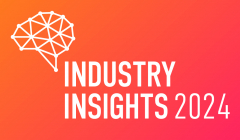
Creativebrief unveils the trends shaping modern marketing
The Industry Insights 2024 report explores the topics on marketing leaders minds today

Weirdo’s Kate Knowles urges brands to consider accessibility in all aspects of work

In all the progress that’s been made in representation of who we show in advertising, it’s remarkable how little has been made in who can see it. From platforms to creators to content, accessibility adjustments are rudimental at best, and simple fixes - like adding subtitles - are often ignored.
It’s beyond belief that, when nearly a quarter of the UK’s population have a disability, audio description, BSL, and closed captions, aren’t more commonplace. If anything, it’s a rarity. With graphic design trends leaning back to maximalism, we’re also seeing contrast ratios and text legibility decline. From an accessibility standpoint, we have a way to go, and if anything we’re slipping back into old habits. But it’s less surprising when you realise accessibility exclusion goes beyond creative - only 9% of people in the advertising sector identify as having a disability.
So we’re once again brought into the age old problem in advertising, that we assume people are giving our creative 100% attention 100% of the time. And we don’t make enough adjustments to ensure that if one sense is distracted or impaired, other senses allow for comprehension.
Kate Knowles, Strategist, Weirdo
The thing is accessibility is for everyone. You have people with temporary accessibility needs, like someone who’s just broken an arm. You have people with situational accessibility needs, like someone browsing in a noisy tube carriage. And you have distracted people, for whom the ad is background noise to a different attentional activity. I recently attended ThinkBox’s ‘vision and sound in advertising’ event, and was struck by footage we were shown of TV advertising tests. Almost no one looked at the screen, most were on their phone, or having a conversation, or making a tea, or all three at the same time. A visual-reliant ad was going to have no impact on Brian, chatting to his wife and scrolling on his phone.
So we’re once again brought into the age old problem in advertising, that we assume people are giving our creative 100% attention 100% of the time. And we don’t make enough adjustments to ensure that if one sense is distracted or impaired, other senses allow for comprehension.
So, accessibility is for everyone.
And we need to make it a priority.
What next?
The good news is, making accessible content is a hugely creative exercise. And it amplifies your creative, both in effectiveness and creative potential.
Accessibility should be in briefing documents and brought in from the outset. Who might be excluded from this content? How can we bring them in and make sure we land our message? What do we need to do to guarantee it? It’s business, after all, the more people that comprehend our ad, the more brand effects.
Some things can be done to improve existing creative. Adding closed captions is one, making sure contrast ratios pass is another, limiting flashing in videos to less than 3 frames a second is another. Running creative past a simple checklist will help maximise accessibility of each execution
Where accommodations can’t be made in the core assets, brief in additional, eg BSL interpretation or audio description.
Work with people who have accessibility needs. And pay them for their time and work. Reach out to accessibility advocacy groups. Pay them too. Build open feedback loops, and prioritise lived experience over assumption.
And this is the key, accessibility is a huge creative springboard. It’s a chance to build out creative in new ways, and give new opportunities for talent to contribute. With Weirdo, we recently helped Arsenal launch their Away Kit, creating an audio described video to sit alongside the core execution, in which AntsLive (featured in the video) brought his personality to the fore. It is my favourite execution, and for many supporters too, adding colour and context to the story.
Platforms like YouTube let you upload a transcript and embed captions in videos. Which is fantastic. But on YouTube and beyond there’s a way to go. It’s not good enough to have to post accessible-version of creative in the comments, especially if someone’s navigating using a screen reader. We the industry need to demand better.
In a world where we’re trying to maximise the impact of every impression, and capture and capitalise on attention, accessibility should be at the front of everyone’s to-do list. Not the end. The brands that do are going to have a gigantic brand advantage, and elevate the experience of many.
Kate Knowles, senior strategist at Weirdo, has over seven years experience working in strategy, with extensive experience planning campaigns for FTSE100 brands and disruptive startups alike. Passionate about inclusion and allyship, she participates in volunteering and mentorship.
Looks like you need to create a Creativebrief account to perform this action.
Create account Sign inLooks like you need to create a Creativebrief account to perform this action.
Create account Sign in